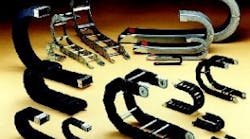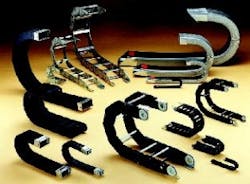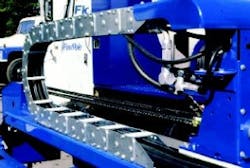When hydraulic or pneumatic lines connect to a moving machine component, there are several ways to accommodate the motion. While the easiest is to simply allow slack hose, this method can lead to excess flexing, premature hose wear, and damage from pinching or exposure to other hazards. Hose reels are another possibility, but generally they are useful only for single or dual lines and may not accommodate longer travel distances or larger hose sizes easily.
Hose and cable carriers
Hose and cable carriers form a flexible shield that pays out and retracts the hose with a smooth, rolling action, which keeps the lines from becoming tangled and prevents fatigue.
Hose carriers can be divided into four basic types: metal link, metal enclosed, non-metallic link and non-metallic enclosed. Each type is best suited to a different combination of application parameters, although the choice is not always clear-cut.
Metal link carriers are simply parallel sidelinks joined by crossbars that accommodate the hoses. Pivot pins and stops allow the links to travel through a predetermined arc. These designs are best for slow-speed, heavy-load applications such as machine tools.
Metal enclosed carriers are formed with small convolutions to provide better protection against chips, weld spatter and other particles. Because carriers of this design are not limited by individual links with their distinct travel arcs and stops, they also can operate at higher speeds, an advantage in applications such as robotics.
Non-metallic link carriers can handle higher speeds while providing greater width and carrying capacity, for applications where greater weight-and hose-carrying capacity are needed for longer travels. This type leaves the hoses open to easy inspection but does not protect against abrasive particles.
Non-metallic enclosed carriers are the best choice for applications that combine the need for fast travel speeds and protection from outside elements.
Few of the lines between parameters are clearly drawn, so it is best to begin working with the hose carrier manufacturer early in the design of any equipment with hydraulic or pneumatic lines that connect moving parts. This will allow greater flexibility in choosing the hose carrier design that will provide the best combination of features for the application.
Here are a few general guidelines for making a preliminary selection. For size decisions, the practical maximum width for an enclosed metal enclosed carrier is about 6 in. Very small sizes, conversely, are easily handled in non-metallic designs, while they are not practical in the metal-link types.
Metal link carriers are restricted to speeds under about 80 ft/min in most applications, although by controlling acceleration and deceleration, considerably higher speeds have been achieved.
Most non-metallic carriers are molded from fiberglass-filled nylon, which provides high strength per unit weight. However at about one-fourth the strength of steel, such materials are not practical for carriers combining large widths, the weights of multiple lines, and long lengths.
These factors all interact to determine the final choice. For example, a low-speed application with moderate particle exposure would probably call for a metal link design. A combination of higher speed and hot welding or grinding spatter would point toward a metal tube. A high-speed application with the need to monitor hoses for leaks would indicate an open non-metallic design, particularly with a large number of hoses. A high-speed application that also needs corrosion resistance — such as a car wash or a machine with heavy coolant spray — would be a logical place for a non-metallic enclosed carrier.
Roll up your sleeves
An important element of achieving long life is that the hose cover be abrasion resistant. Abrasive wear occurs when a hose repeatedly rubs against another hose or against a machine element. Another cause of premature hose failure occurs when hoses are bent beyond the minimum radius specified by the manufacturer. Many times, this excessive bending is unintentional, and results from hoses getting tangled, kinked, pulled, or twisted.
Products and accessories are available to protect hose from hostile environments, abrasion, tangling, stretching, and excessive bending. Often, a single product can protect the hose from more than one of these potentially damaging conditions. An important characteristic to consider when selecting a device is how to install it. For original equipment or equipment overhaul, it often can be incorporated into the hose assembly during installation. However, if it will be added to existing equipment, you should ensure that the device can be installed without having to disconnect and reattach hose assemblies.
Hose sleeves are designed to protect hoses from abrasive wear and other hostile conditions. They simply slip over the end of a hose assembly, or they may also be split to allow installing them around a hose assembly already mounted on equipment. Loose-fitting sleeves (split or continuous) often are used to bundle two or more hoses into a neat assembly to prevent tangling as well as isolating the hoses from hostile conditions.
A sleeve designed to protect a single hose assembly usually comes with fasteners to attach it to the hose end. It may also be bonded directly to the hose cover. This type of hose sleeve often is used with long sections of hose. Instead of specifying a long section of abrasion-resistant hose, the sleeve can be installed only on the section of hose that is in contact with adjacent components. This saves money over specifying a long section of abrasion-resistant hose when only a small section of the hose will be subjected to abrasion. A third type of sleeve resembles a spring that winds around the hose in a helix.
Loose-fitting hose sleeves generallyare made of high-strength fabric-and coated or impregnated with appropriate materials to resist chemicals, heat, particles, moisture, etc. Bonded hose sleeves usually are made of tough thermoplastics that resist abrasion. Care must be taken to ensure that any adhesive-used with the bonded sleeve is compatible with the hose cover. The helical-type sleeve comes in a wide variety of materials, including thermoplastics or stainless steels.
Bend restrictors, which resemble springs, fit around the outside of a hose and resist bending. They must be applied carefully to prevent the restrictor from wearing away the hose cover. They often are used on the end of a hose to prevent excessive bending at the critical hose-fitting interface. Keep in mind that these devices are not intended to correct poor design practices. If a hose undergoes severe bending at one end, a longer hose, swivel fitting, or both should be specified.
Mark Cunningham is national sales manager at A & A Mfg. Co., New Berlin, Wis. For more information on Gortrac hose and cable carriers, visit www.gortrac.com.



